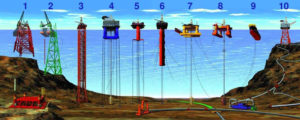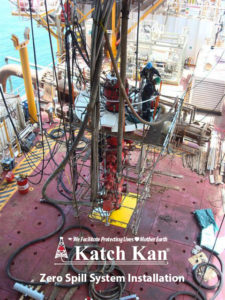We’ve come a long way since the beginning of the deepwater operations with the first offshore platform installed 21 ft under water in 1947; and now drilling operations exceeding the 10,000 ft mark, thanks to the evolution of technologies and new drilling techniques.
Offshore rigs are large structures classified into 2 main categories, fixed to the seabed or floating. There are different types of structures in each category to choose from, depending on the characteristics of each individual project. Floating platforms can be easily relocated to other drilling locations and are usually used for exploration while Fixed platforms are commonly constructed in shallow water and require more investment. Offshore projects take average between 5 to 10 years from conception to implementation and require highly qualified personnel to operate. There are several important factors that influence decision making in choosing the right structure for the project, like depth and pressure constrains, oil and gas reserve and type of reservoir, lifespan of the reservoir and platform flexibility requirements to relocate, expand and decommission.

1, 2) conventional fixed platforms; 3) compliant tower; 4, 5) vertically moored tension leg and mini-tension leg platform; 6) spar; 7, 8) semi-submersibles; 9) floating production, storage, and offloading facility; 10) sub-sea completion and tie-back to host facility Image Courtesy: (NOAA), US Department of Commerce & Wikipedia

New technology developed after 1947 made exploration and production possible, but the investment needed for offshore compared to onshore operations is still considerable high. There are still challenges due to high rates for exploration, infrastructure cost, complexity of the reservoir and the market volatility. More advanced technology will be a critical factor to help compete with onshore shale and potentially reduce the overall deepwater project cost.
Deepwater research and development around the world is focusing in improving drilling techniques and equipment to overcome potential risk, subsea well control, spill containment and spill response to mitigate environmental concerns.
The remaining big reserves of oil and gas are located under water and with several notable discoveries over the past years, deepwater prospects remain an important part of future global oil and gas supply and it will continue to attract significant company interest.




